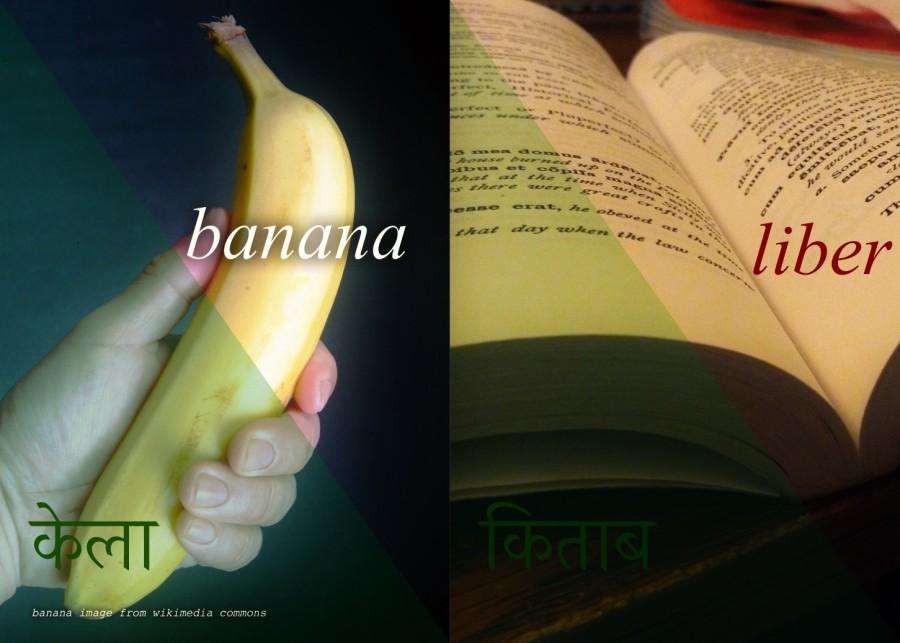The lens of a new language
Mundane objects such as bananas and books become interesting when viewed through the lens of a new language.
When I think, I think in English. It was the first language I learned and remains the only one in which I am fluent. Like a trend line through a set of data or a pathway on a map, English helps me form thoughts and take actions based on sight, sound and memory.
When I see a book on a shelf, I use knowledge to decide whether or not to read it. It is through English that I read the words on the spine identifying the book series and author, and through English that I weigh the matter of whether I should spend time reading the book in my mind. And of course, English is necessary to actually read the book and absorb the knowledge it contains.
Minor tasks like this are so common and essential to my day that English has become embedded into many parts of my worldview and perspective. As a result, learning a new language can spice up aspects of life ranging from conversations to stories like garlic salt added to a familiar dish.
Having grown up speaking primarily English, I began to learn Latin in sixth grade. I knew only rudimentary grammar and vocabulary at first, but Latin still held a unique appeal. I relished each new piece of grammar that I could add to my Latin toolkit, which I used to cobble together sentences in attempts to converse with my fellow students. Using newly acquired knowledge of personal pronouns to say “Ego sum Praveen!” was far more interesting than repeating the English that I had known for years: “I’m Praveen.”
Even in those early days, I began to gain the second perspective that a new language can provide. Simple, conversational speech became engaging in an unfamiliar tongue.
I have found new opportunities for discovery this year: my fourth year of Latin. When my Latin class read fairy tales such as “Tres Porcelli,” or “Three Little Pigs,” this year, the experience threw the classic story into the world of Latin idiom and syntax. A simple, familiar story became fresh and interesting again when seen through the Latin lens.
It’s this freshness, this mixed sense of familiarity and newness, that makes using a new language, even for linguistically mundane tasks, so exciting. Every small mental act that contributes to the processing of words, even if easily ignored in English, can suddenly become an engaging activity in a foreign tongue.
As I have begun to learn Hindi, I again feel the refreshing novelty of the language. Hindi’s script, Devanagari, uses completely different characters than English—so even reading words that I know is an intellectually engaging activity, with each identified letter a reason to rejoice. And Devanagari characters stand for precise sounds instead of the wide range of sounds a single English character can stand for, so my studies of the script are closely linked with my pronunciation.
I have been able to use snippets of Hindi, ranging from words such as केला, or “banana,” to simple sentences such as “I have the book,” in conversations with my parents. And, with much assistance from them, I have even tried to read a Hindi translation of “Harry Potter and the Prisoner of Azkaban.” This experience has brought a new dimension to a book I have read countless times already, even though I have only been able to translate a few sentences thus far.
Learning a new language is thrilling. But every stumble I make while learning reminds me that English deserves great respect as well. While reading a single sentence may rarely be an interesting and challenging exercise in English, my fluency in the language has allowed me to climb to more advanced uses of it: writing essays, conversing and, of course, thinking. If studying Latin literature or speaking Hindi is like traveling abroad to experience foreign worlds, then English is my home: the place I am most familiar with.

Praveen Batra (9) is a reporter for the Winged Post. He enjoys informative writing, design, and typography. In his spare time, he likes to write mobile...


















![“[Building nerf blasters] became this outlet of creativity for me that hasn't been matched by anything else. The process [of] making a build complete to your desire is such a painstakingly difficult process, but I've had to learn from [the skills needed from] soldering to proper painting. There's so many different options for everything, if you think about it, it exists. The best part is [that] if it doesn't exist, you can build it yourself," Ishaan Parate said.](https://harkeraquila.com/wp-content/uploads/2022/08/DSC_8149-900x604.jpg)




![“When I came into high school, I was ready to be a follower. But DECA was a game changer for me. It helped me overcome my fear of public speaking, and it's played such a major role in who I've become today. To be able to successfully lead a chapter of 150 students, an officer team and be one of the upperclassmen I once really admired is something I'm [really] proud of,” Anvitha Tummala ('21) said.](https://harkeraquila.com/wp-content/uploads/2021/07/Screen-Shot-2021-07-25-at-9.50.05-AM-900x594.png)







![“I think getting up in the morning and having a sense of purpose [is exciting]. I think without a certain amount of drive, life is kind of obsolete and mundane, and I think having that every single day is what makes each day unique and kind of makes life exciting,” Neymika Jain (12) said.](https://harkeraquila.com/wp-content/uploads/2017/06/Screen-Shot-2017-06-03-at-4.54.16-PM.png)








![“My slogan is ‘slow feet, don’t eat, and I’m hungry.’ You need to run fast to get where you are–you aren't going to get those championships if you aren't fast,” Angel Cervantes (12) said. “I want to do well in school on my tests and in track and win championships for my team. I live by that, [and] I can do that anywhere: in the classroom or on the field.”](https://harkeraquila.com/wp-content/uploads/2018/06/DSC5146-900x601.jpg)
![“[Volleyball has] taught me how to fall correctly, and another thing it taught is that you don’t have to be the best at something to be good at it. If you just hit the ball in a smart way, then it still scores points and you’re good at it. You could be a background player and still make a much bigger impact on the team than you would think,” Anya Gert (’20) said.](https://harkeraquila.com/wp-content/uploads/2020/06/AnnaGert_JinTuan_HoHPhotoEdited-600x900.jpeg)

![“I'm not nearly there yet, but [my confidence has] definitely been getting better since I was pretty shy and timid coming into Harker my freshman year. I know that there's a lot of people that are really confident in what they do, and I really admire them. Everyone's so driven and that has really pushed me to kind of try to find my own place in high school and be more confident,” Alyssa Huang (’20) said.](https://harkeraquila.com/wp-content/uploads/2020/06/AlyssaHuang_EmilyChen_HoHPhoto-900x749.jpeg)



